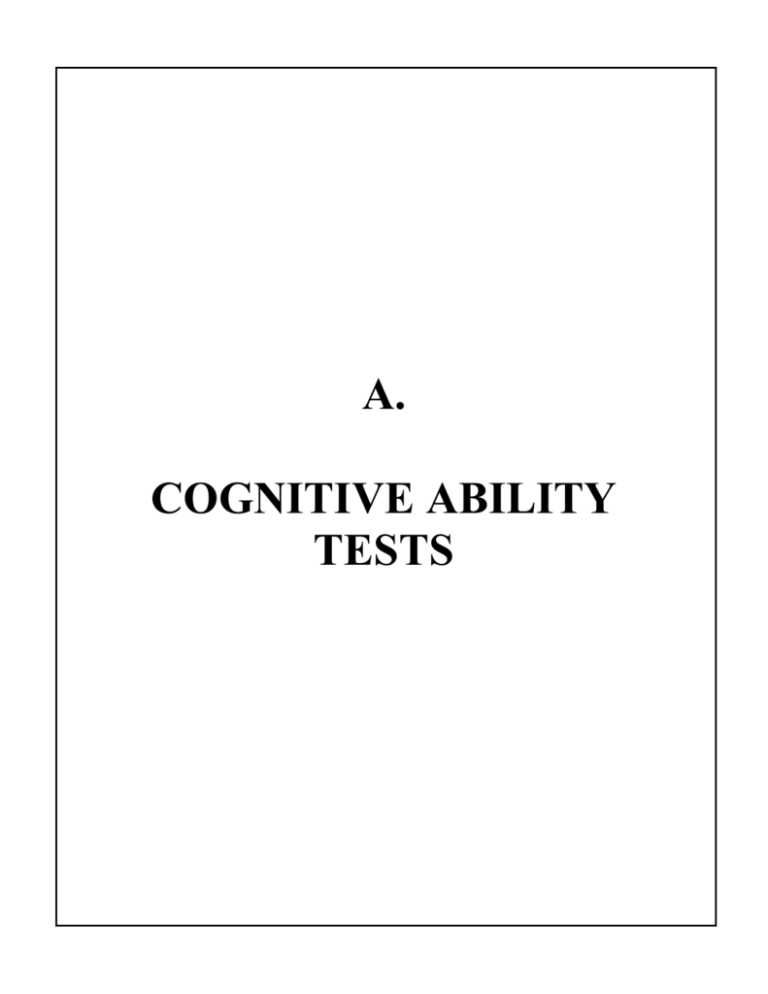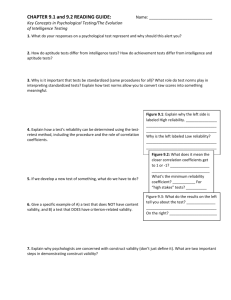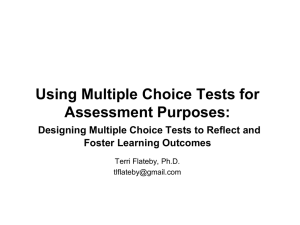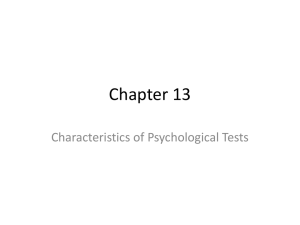Cognitive Ability Tests
advertisement

A. COGNITIVE ABILITY TESTS (i) GENERAL APTITUDE TEST BATTERY (GATB) Author: N/A Publisher: U.S. Employment Service (USES), Division of Testing Publication Date: 1945 Purpose: The USES developed this test to match people’s intelligence with jobs that were well suited for them. Population: All job applicants Cost: N/A Time: N/A Norms: 515 validation studies over 30 years. N=32,124 workers Reliability: Stability Coefficient 0.81 (corrected) Validity: Convergent Validity for subtests ranged from 0.50-0.89 (corrected) Test User: N/A Summary/Critique: The GATB consists of 12 separately timed subtests which make up 9 aptitude scores (intelligence, verbal aptitude, numerical aptitude, spatial aptitude, form perception, clerical perception, motor coordination, finger dexterity, and manual dexterity). This test is one of the oldest general mental ability tests still used today and is considered by some researchers to still be unparalleled by other tests. (ii) KBIT: KAUFMAN BRIEF INTELLIGENCE TEST Author: Alan S. Kaufman and Nadeen L. Kaufman Publisher: American Guidance Service Publication Date:N/A Purpose: The KBIT was designed to provide insight into significantly different scores on verbal and nonverbal intelligence. Population: This test can be used for educational and noneducational settings Cost: Intro Kit: $609.00 Time: Core Battery: 60 minutes Extended Battery: 90 minutes Norms: N/A Reliability: Internal consistency reliabilities: (all corrected) .94 for the overall KBIT IQ Composite .93 for the Vocabulary subtest .88 for the Matrices subtest Test-Retest reliabilities: (all corrected) .92-.95 for the IQ Composite .86-.97 for the Vocabulary subtest .80-.92 for the Matrices subtest Validity: Each item was tested for construct validity throughout the development process. Concurrent validity was established by: (all corrected) analysis with the WISC-R (.81) analysis with the WAIS-R (.81) analysis with the Stanford-Binet (.87) Test User: Qualification Level C Summary: The Vocabulary Subtest (verbal) measures crystallized thinking through knowledge of words and their meanings. The Matrices Subtest (nonverbal) measures fluid thinking by assessing the ability to solve new problems through perceiving relationships and completing analogies. All items of the Matrices Subtest contain pictures and abstract designs rather than words so nonverbal abilities can be assessed even when language skills are limited. (iii) MULTIDIMENSIONAL APTITUDE TEST BATTERY-II (MAB-II) Author: Dr. Douglas N. Jackson, Ph.D. Publisher: Sigma Assessment Systems P.O. Box 610984 Port Huron, MI 48061-0984 1.800.265.1285 Publication Date: 1998 Purpose: The MAB-II is used to assess general mental ability with ten subtest scores: Verbal IQ, Performance IQ, and Full Scale IQ. Population: Used on psychological patients (in clinics or in counseling), schools, referral agencies, and on applicants for employment. Cost: MAB-II Machine Scoring Examination Kit $43.00 MAB-II Hand Scoring Examination Kit $59.00 Time: 100 Minutes for entire test (7 minute time limit for each battery) Norms: N/A Reliability: Full Scale 0.91 Test-Retest (45 Day Separation) Verbal 0.95, Performance 0.96, Correlated with unmentioned validated IQ measure at 0.91 (corrected) Validity: N/A Test User: Level B Summary/Critique: Test can be individually or group administered. One specific use is for aptitude assessment in employment settings. The subtests are: Verbal (information comprehension, arithmetic, similarities, vocabulary), Performance (digit symbol, picture completion, spatial, picture arrangement, object assembly), and Total (verbal, performance, full scale). Validity information is most definitely contained within the test manual but the manual was not obtainable. The test must be purchased in order to get the manual. (iv) SLOSSON INTELLIGENCE TEST-REVISED (SIT-R) Author: Richard L. Slosson Publisher: Slosson Educational Publications, Inc. Dept. S PO Box 280, 538 Buffalo Road East Aurora, NY 14052-0280 Phone: 1-888-SLOSSON (756-7766) Publication Date: 1998 Purpose: The SIT-R is used to evaluate an individual’s general mental ability and is very useful for screening applicants. Population: Used for employment purposes mainly, but some for psychological patients and as general IQ measure. Cost: Complete Kit $78.00 Time: 10-20 minutes for administration and scoring (Total Time) Norms: The SIT-R was standardized on 1, 854 individuals loosely matched to the U.S. population with respect to educational and social characteristics. Reliability: KR-20 0.90 and up (corrected) Validity: Validity Coefficients range from 0.83-0.91 (corrected) Test User: Measurement Class N/A but mentioned needing a minimum of a Testing and Summary/Critique: The SIT-R is a relatively fast test because administration and scoring is done simultaneously. It taps the domains of vocabulary, general information, similarities and differences, comprehension, auditory memory, and quantitative ability. (v) STANFORD-BINET INTELLIGENCE SCALE, FOURTH EDITION Author: Robert L. Thorndike, Elizabeth Hagen, and Jerome Sattler Publisher: Riverside Publishing 8420 Bryn Mawr Avenue Chicago, IL 60631 Publication Date: 1986 Purpose: This test was designed to reflect the theory of fluid and crystallized abilities with measurement practice. It is a three level hierarchical cognitive abilities model which incorporates the g-factor and 4 cognitive areas (verbal reasoning, abstract/visual reasoning, quantitative reasoning, and short-term memory). Population: This test is an important instrument in clinical and educational settings Cost: N/A Time: Varies depending of number of subtests administered Norms: N/A Reliability: Median reliabilities for Composite Score across all ages is .97 (corrected) Subtest reliabilities are typically in the .80-.90 range (corrected) Validity: N/A Test User: N/A Summary: The fourth edition of the Stanford-Binet Intelligence Scale assesses intelligence and cognitive abilities. Features of this test include: multiscore adaptive abilities test allows users to observe similar characteristics from ages 2 to adult provides scaled scores for 15 tests in 4 areas offers 4 area scores and a composite score format organizes items according to type and order of difficulty includes a routing test given initially to all examinees latest psychometric approaches, including IRT, used in test development provides a single instrument that can be used with all age groups multiple test scores allow users to make better overall diagnoses allows better assessment of ability level for each item type allows users to enter each test with more information than chronological age (vi) THE WOODCOCK-JOHNSON III STANDARD Author: Richard W. Woodcock, Kevin S. McGrew, and Nancy Mather Publisher: DLM Teaching Resources One DLM Park Allen, TX 75002 Publication Date: 1990 Purpose: The Woodcock-Johnson Test of Cognitive Ability was designed to produce an instrument that can be used with confidence in a variety of educational and noneducational settings. It can be used for program placement, guidance, assessing growth, program evaluation, and research. Population: This test can be used for educational and noneducational settings Cost: Complete Battery $925.00 Time: 35-40 minutes Norms: N/A Reliability: Median reliability: (all corrected) Kindergarten to Grade12 range = .93 Adult range = .97 Validity: The correlation of the broad cognitive cluster is in the .60 - .70 range (corrected) Test User: N/A Summary: The Standard Battery of the WJ-R COG consists of seven tests, each of which measures a different intellectual ability. 1. Memory for Names- measures the ability to learn associations between unfamiliar auditory and visual stimuli (an auditory-visual association task). This test primarily measures long-term retrieval. 2. Memory for Sentences- measures the ability to remember and repeat single words, phrases, and sentences presented auditorily by use of a tape player. This test primarily measures short-term memory and attention. 3. Visual Matching- measures the ability to locate and circle the two identical numbers in a row of six numbers. The task proceeds in difficulty from single-digit numbers to triple-digit numbers and has a 3-minute time limit. This test primarily measures processing speed. 4. Incomplete Words- tape-recorded test that measures auditory closure. The subject must identify incomplete words. This test primarily measures auditory processing 5. Visual Closure- measures the ability to identify a drawing or picture that is altered in one of several ways. This test primarily measures visual processing. 6. Picture Vocabulary- measures the ability to recognize or to name familiar and unfamiliar pictured objects. This test primarily measures comprehensionknowledge or crystallized intelligence. 7. Analysis-Synthesis- measures the ability to analyze the presented components of an incomplete logic puzzle and to determine the missing components. This test primarily measures reasoning, or fluid intelligence. (vii) WECHSLER ADULT INTELLIGENCE SCALE-THIRD EDITION (WAISIII) Author: David Wechsler Publisher: The Psychological Corporation, Harcourt Brace & Company 1-888-677-7357 Publication Date: 1997 Purpose: The WAIS-III is an individually administered cognitive ability test that assesses general intellectual ability with people in the age range of 16-89. Population: Not specified but seems to be appropriate for most any adult. Cost: N/A Time: N/A Norms: N/A Reliability: Average reliability coefficient 0.82-0.93 (except for subjects of picture arrangement, symbol search, and object assembly, they ranged from 0.77-0.77) WAIS-III IQ scales 0.88-0.97 (corrected) Validity: Three Composite Score Validities (corrected) VIQ 0.94 PIQ 0.86 FSIQ 0.93 Test User: Level C. Summary/Critique: Unfortunate that more information could not be found on such a widely used test. Verbal IQ, Performance IQ, and Full Scale IQ are the three composite scores. The WAIS-III also has four index scores (Verbal comprehension, Perceptual organization, Working memory, and Processing speed) and 14 subtests (picture completion, vocabulary, digit symbol-coding, similarities, block design, arithmetic, matrix reasoning, digit-span, information, picture arrangement, comprehension, symbol search, letter-number sequencing, and object assembly). (viii) THE WONDERLIC PERSONNEL TEST (WPT) Author: N/A Publisher: Wonderlic,Inc. 1795 N. Butterfield Road Libertyville, IL 60048 1.800.323.3742 Publication Date: 1938 Purpose: The WPT measures general adult intelligence and has mostly been used to best match individuals with work positions that best utilize their knowledge. Population: Mostly used in work settings. Cost: Paper and Pencil Version 25 tests for $105.00 or 100 tests for $200.00 PC Version 25 tests for $105.00 or 100 tests for $200.00 Time: 12 minutes Norms: N/A Reliability: Internal Consistency 0.88-0.94 (both corrected) Parallel Forms 0.82-0.94 Validity: Criterion-Related 0.22-0.53 (not sure if corrected or not) Test User: N/A Summary/Critique: The WPT assesses such traits as learning speed, problem-solving ability, understanding and following instructions, and ability to learn and apply knowledge to new situations. The WPT is perhaps the most widely used mental ability test in use today. Many large organizations (i.e., NFL) choose this test, mainly for the cost and time efficiency it provides. The test manual provides in depth validity and reliability charts. REFERENCES FOR COGNITIVE ABILITY TESTS Multidimensional Aptitude Test Battery-II (MAB-II) http://www.sigmaassessmentsystems.com The Wonderlic Personnel Test (WPT) http://www.wonderlic.com Wonderlic Personnel Test Manual, 1983 as reported by Whitney, D.J., & Schmitt, Neal. Relationship Between Culture and Responses to Biodata Employment Items. Journal of Applied Psychology, 82, 1, 113-129. Guion, R. (1965) Personnel Testing. New York: McGraw-Hill, 234. Foley, J. (1972) Review of the Wonderlic Personnel Test. The Seventh Mental Measurements Yearbook, 401-403. Wechsler Adult Intelligence Scale-Third Edition (WAIS-III) http://www.ericae.net/te/TCO20235.htm WAIS-III Technical Manual. The Psychological Association: Harcourt Brace & Company. San Antonio, 1997. Slosson Intelligence Test-Revised (SIT-R) SIT-R Test Manual. Slosson Educational Publications, Inc. East Aurora, New York. http://www.slosson.com General Aptitude Test Battery (GATB) http://www.ericae.net/tc2/TC001422.htm Fairness in Employment Testing: Validity Generalization, Minority Issues, and the General Aptitude Test Battery. National Research Council, 1989. Hunter, J. E. (1986). Cognitive Ability, Cognitive Aptitudes, Job Knowledge, and Job Performance. Journal of Vocational Behavior, 29, 340-362. Stanford-Binet Intelligence Scale, Fourth Edition http://www.riverpub.com/roducts/clinical/sbis_indepth.html Thorndike, R.L., Hagen, E.P., Sattler, J.M., (1986). Stanford-Binet Intelligence Scale: Fourth Edition-Technical Manual, Chicago, IL: The Riverside Publishing Company. Kaufman Brief Intelligence Test (KBIT) http://www.adsnet.com/templates/productview.asp?group=a3350 Hunter, J. E. (1986). Cognitive Ability, Cognitive Aptitudes, Job Knowledge, and Job Performance. Journal of Vocational Behavior, 29, 340-362. The Woodcock-Johnson III Standard http://www.riverpub.com/roducts/clinical/wj3_indepth.html Woodstock, Richard W., Mather, Nancy, (1989, 1990). Tests of Cognitive Ability: Standard and Supplement Batteries-Examiner’s Manual, Allen, TX: DLM Teaching Resources. Woodstock, Richard W., Mather, Nancy, (1989). Tests of Cognitive Ability: Standard and Supplement Batteries-Norms Tables, Allen, TX: DLM Teaching Resources.








